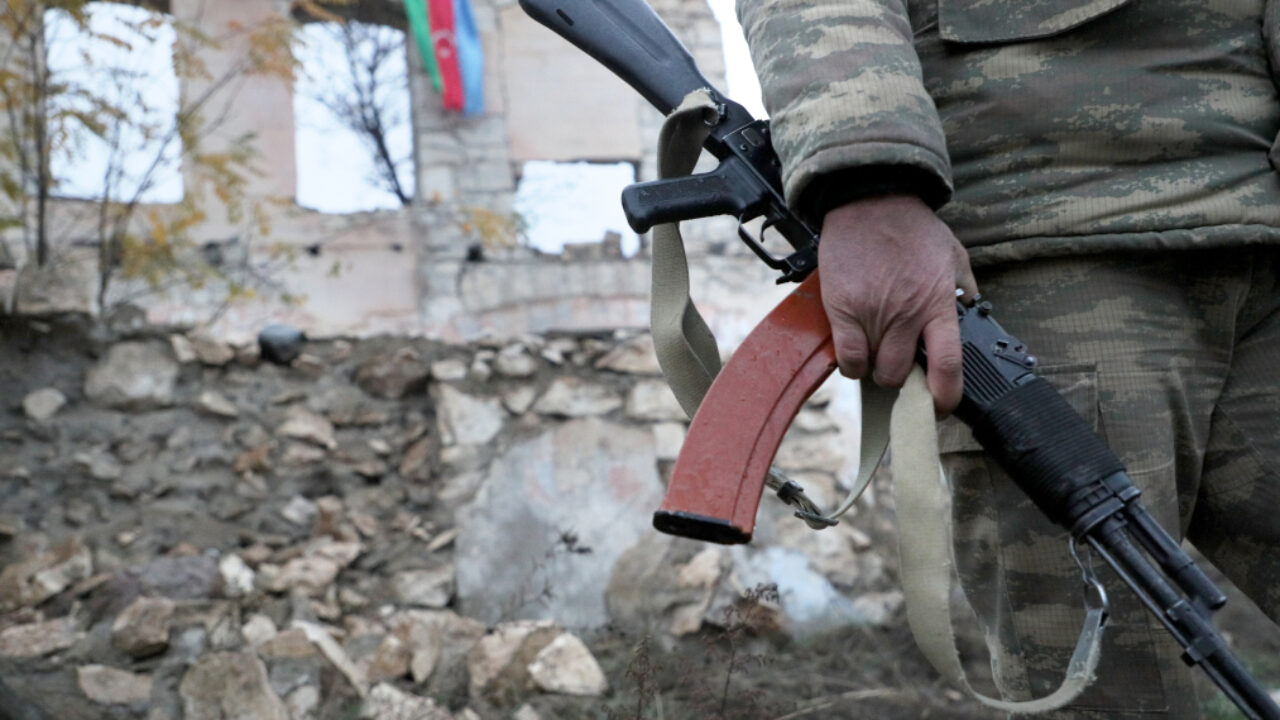Military lessons from Nagorno-Karabakh: Reason for Europe to worry
The 2020 Nagorno-Karabakh war holds important lessons for European defence. European governments should study it urgently
In the last decade, it was no secret that Azerbaijan was steadily building up its armed forces. But, despite this, few experts predicted this month’s clear-cut military victory by Azerbaijan over Armenia. Much of this victory is credited to the technical and financial side of the war: Azerbaijan was able to afford more and it had Turkish and Israeli technology that was simply better than what Armenia had to draw on. But the lessons of the 2020 Nagorno-Karabakh war go deeper and are more complex than just questions of technology. And they hold distinct lessons for how well Europe can defend itself.
Lesson 1: Strategy and politics matter
The course of every war is influenced by the specific political circumstances that trigger it – and this war was no exception. Azerbaijan and Turkey were confident in the success of their offensive action, as Russia had from the onset of the war indicated that it had no intention of assisting the Armenians outside of their recognised borders. Russia also saw Azeri military pressure as a tool to weaken the Armenian prime minister, Nikol Pashinyan, who headed the 2018 revolution that removed the old regime. Azeri action would, moreover, be likely to lead Armenia accept previously negotiated “peace plans” that would strengthen Moscow’s geopolitical position. This adverse political situation directly translated into military disadvantages on the battlefield for the Armenians.
Knowing Moscow’s tacit acceptance of a military intervention, Turkey based several F-16 fighters in Azerbaijan in October 2020 as a general deterrent. These were later used to sweep the sky of any Armenian ground-attack aircraft that tried to engage in combat. For its part, Armenia had just received eight Su-30 interceptors from Russia this summer, but did not even try to use them to contest the Azeri drones and F-16. The main reason for this was that Russia wanted Armenia not to enter into a direct confrontation with Turkey proper, and so it kept its aircraft on the ground. Russia effectively served air superiority on a diplomatic silver platter to Azerbaijan and Turkey. This proved decisive.
Lesson 2: Computers and networks matter
Like in Syria and Libya, Russian air-defence systems proved to be ineffective against small and slow drones. This has inspired a debate in the West about whether Russian air-defence systems are generally overrated. But this verdict would be premature.
Russia effectively served victory on a diplomatic silver platter to Azerbaijan and Turkey.
Armenia’s most ‘modern’ air-defence systems, the S-300PT and PS series and the 9K37M Buk-M1, were both developed in the 1980s. While the missiles are still potent, their sensors are designed to detect, identifiy and track fast-moving fighters, and their moving-target indicators disregard small, slow drones. Like many 1980s systems, a lot of computing is predetermined by hardware layout, and reprogramming requires an extensive refit of the entire system, which the Armenians had not done. These systems are also incapable of plot-fusion: accumulating and combining raw radar echoes from different radars into one aggregated situation report. Plot-fusion is essential to detecting small and low-observable targets such as advanced drones or stealth aircraft. None of the export versions of Russia’s air-defence systems that it has sold to Syria, Turkey, North Korea, and Iran are capable of plot-fusion. (In the latter two cases, these are disguised as ‘indigenous’ systems like the Raad or Bavar 373.) There is therefore a huge difference in performance between Russian air-defence systems protecting Russian bases in Armenia and Syria and those Russian air-defence systems exported to Armenia and Syria.
Azerbaijan’s drones roamed free because Armenia had no jammer able to interrupt the signals linking the drones to their guidance stations. Only in the last days of the war did Russia use the Krasukha electronic warfare system based at the Armenian city of Gyumri to interdict Azeri deep reconnaissance in Armenia proper. Still, the Azeris also used the Israeli Harop loitering munition, which was able to work under adverse conditions (although at reduced effectiveness) as it does not, unlike drones, require a guidance link. Hence among armies that are likely to prepare to fight wars in the future – not only the US, China, Russia but regional powers such as Turkey, Israel, and South Africa – this experience will certainly prompt further research into artificial intelligence and autonomous lethal weapons systems. Rather than banning this class of ammunition by a prohibitive arms control treaty, as envisioned by Europe, they will experiment with how to make use of the new technologies and best integrate autonomous lethal weapons systems into their combined-arms manoeuvre forces, thereby increasing their operational tempo and effectiveness.
Lesson 3: Fight ‘around’ the enemy’s strength
Before the war, on a tactical level the Armenian army was superior: it had better officers, more motivated soldiers, and a more agile leadership. In all previous wars with Azerbaijan, this proved to be decisive. But Azerbaijan found a way to work around it. This is where the drones came in: they allowed the Azeris to reconnoitre first the Armenian position and then the placement of reserves. Armenian positions then could be extensively shelled with conventional artillery, weakening their defences. Drones then guided the onslaught towards the Armenian reserves, bringing in artillery, multiple-rocket systems with cluster munitions, their own missiles, or using Israeli-made LORA ballistic missiles to destroy bridges or roads linking the reserves with the front. Once the Armenian side was incapable of sending reserves into battle, the Azeri army could move in any number it wished to overwhelm the isolated Armenian positions. This procedure was repeated day after day, chipping one Armenian position away each day and resupplying artillery during the night.
This tactic also worked well in mountainous territory the Armenians thought would be easy to defend. In the mountains, there is only one road connecting the front to the rear, which made it even easier for drones to spot targets. When the battle over Shusha demonstrated that the Armenians would not stand a chance even in this territory, the Armenian army started to disintegrate and Yerevan had no choice than to agree a ceasefire on adverse terms.
In the West, much of the drone discussion has focused on the technical side of drone warfare. But this aspect was less spectacular in this war. The numbers of vehicles claimed to be destroyed are most likely exaggerated – for example, this Azeri-language Sputnik report claims that more tanks were destroyed than the number of tanks Armenia has in active duty. The Azeri tactical use of drones was impressive, as was the way they embedded them in conventional armoured operations to work around the strength of the opponent’s armed forces. This intellectual creativity should probably be assigned to Turkish military advisers, who, by refining Azerbaijan’s way of fighting, contributed as much to Baku’s victory as the delivery of hardware.
Europe should look carefully at the military lessons of this conflict, and not dismiss it as a minor war between poor countries. Since the cold war, most European armies have phased out gun-based self-propelled air-defence systems. Man-portable air-defence systems (MANPADS) like the Stinger and Igla – the primary short-range air-defence systems in Europe – have little chance of acquiring such small targets like loitering munitions or small drones invisible to the operator. In the recent Nagorno-Karabakh war more MANPADS were destroyed by drones than they could shoot down drones themselves. No European army has a high-resolution sensor-fusion- or plot-fusion-capable armoured air-defence system to protect its own armour. Only France and Germany have (short range) anti-drone jammers and base-protection assets. Most of the EU’s armies – especially those of small and medium-sized member states – would do as miserably as the Armenian army in a modern kinetic war. That should make them think – and worry.
The European Council on Foreign Relations does not take collective positions. ECFR publications only represent the views of their individual authors.



